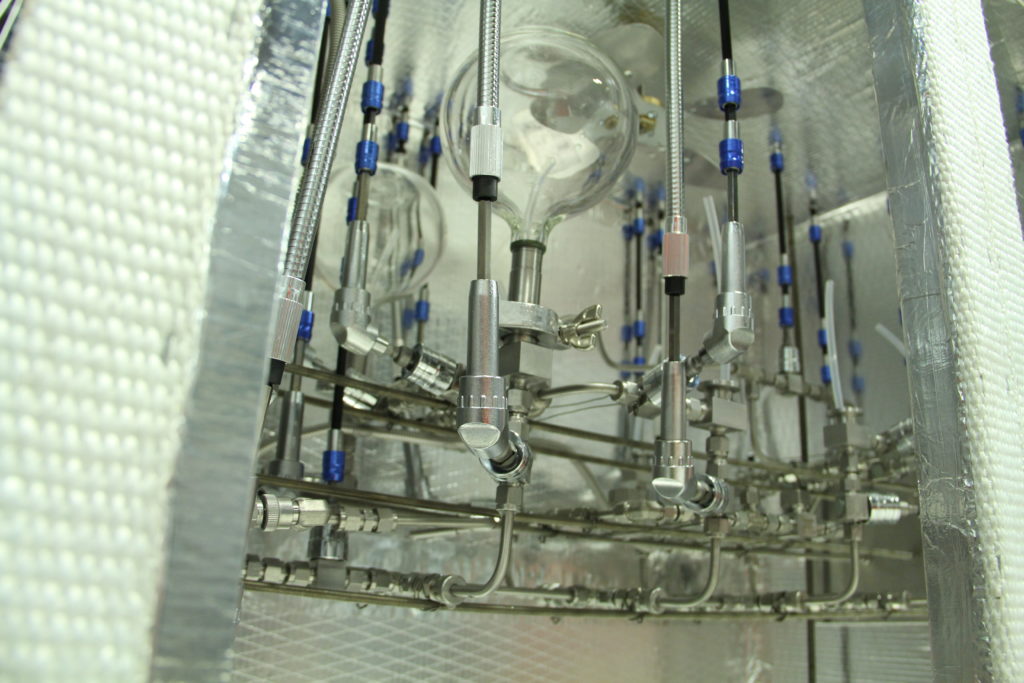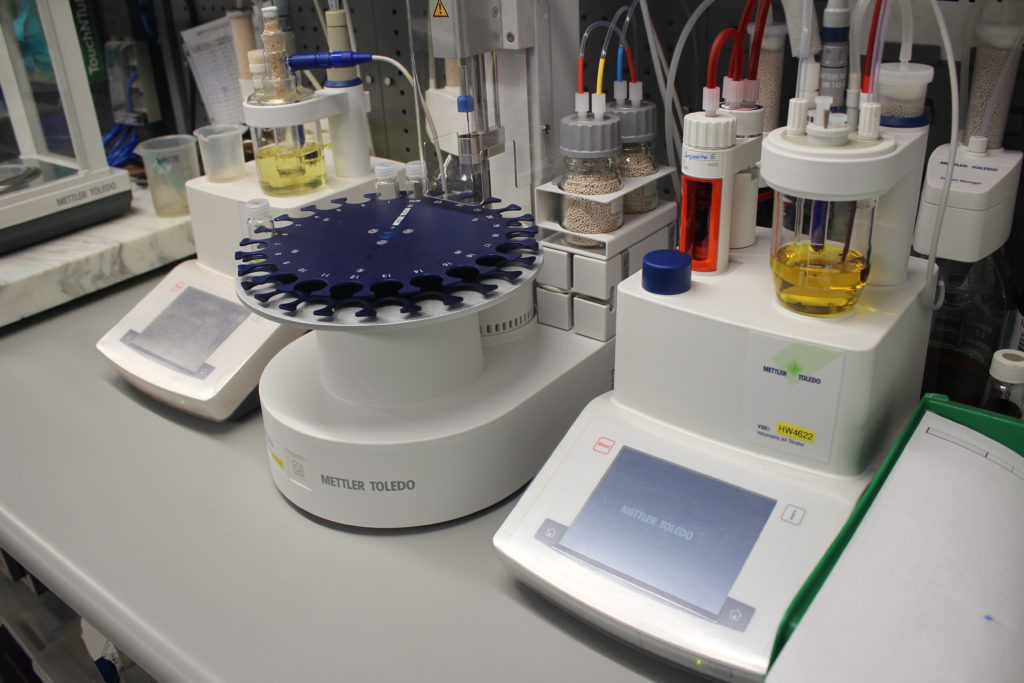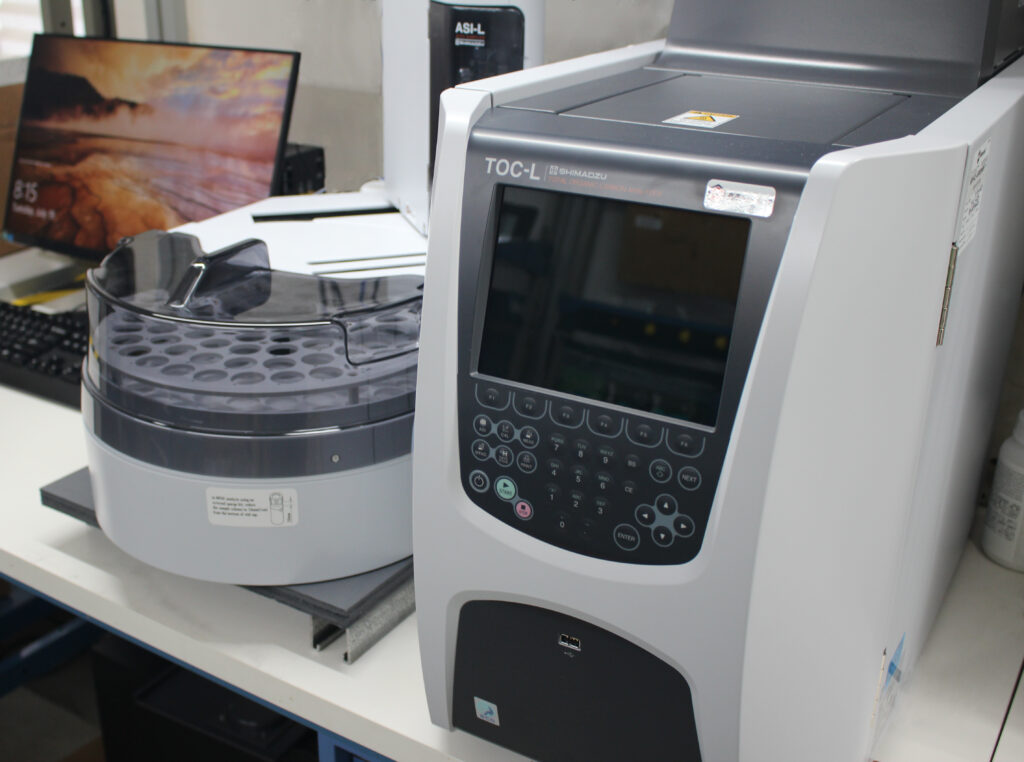
Supporting Analytical Chemistry and beyond
Our Burnaby and Edmonton locations host a wide range of advanced measurement and analytical chemistry instrumentation and techniques in our versatile climate controlled spaces. Our Analytical Laboratories operate as a stand-alone service, with fee-per-sample pricing structures available; as well is integral to our Physical modeling and Client Research programs.
Gas Chromatography
We have a wide variety of gas chromatographs at our disposal. Capabilities include GC-Mass Spectrophotometry Detectors, conventional auto-injector bench-top GCs with Flame Ionization Detectors, and multi-channel micro-GCs with Thermal Conductivity Detectors. These instruments provide analysis of Permanent Gasses, Simulated Distillation, Detailed Hydrocarbon Analysis, and a range of other measurements. Combining the GC-MSD and NIST databases, we can provide detailed compositional analysis and investigate complex sample matrices while developing custom analytical methods for our clients.
- Agilent 6890 GC with FID and MSD, Cool-on Column, and Auto-injection
- Agilent 6890 GC with FID, Cool-on Column, Auto-injection
- Agilent 6890 GC with FID and TCD, Auto-injection
- Agilent 490GC microGC 3-channels with TCD, 16-port Valve

Gas Chromatograph
Ion Chromatography
Coanda’s Metrohm 940 Professional IC Vario dual channel system is configured for aqueous analysis of Anion and Cations simultaneously, or independently. Based on the principles of Liquid Chromatography, our Ion Chromatography uses chemical suppression conductivity detector for Anion analysis, and a separate channel with non-suppressed conductivity detector for Cation analysis. Coanda’s IC is customizable to analyze a wide range of sample types, including aqueous samples, organic solvents, and complex matrices. It can handle a diverse range of analytes, including inorganic ions, organic acids, and polar compounds; while ensuring accuracy of results down to part-per-billion ranges and reducing analysis time through its automated sampling and injection system. The IC’s selectivity, sensitivity, and broad range of applications, is an indispensable tool in numerous scientific disciplines ranging from environmental analysis, pharmaceutical research, food and beverage analysis, and water quality assessments.

Metrohm 940 Professional IC Vario Ion Chromatograph
X-Ray Diffractometer
The Rigaku mini-flex 6G bench-top X-Ray Diffractometer is our crystalline identification and quantification analytical instrument. Coanda employs a unique configuration to reduce the interference of iron in conventional Copper-sourced XRDs. The Rigaku MF6G incorporates a multi-position sample changer, broad 0-180 2-theta degree scan range, and using the Hypix-400 HPAD detector can generate 1D and 2D scans that provide phase identification, quantification, size and strain, and molecular structure when referenced with the Inorganic Crystal Structure Database (ICSD). Coanda specializes in the identification and quantification of clays in tailings using the Rigaku MF6G XRD.

Rigaku mini-flex 6G bench-top X-Ray Diffractometer
Vapour-Liquid Equilibrium Apparatus
The VLE apparatus allows samples to separate into equilibrium liquid and vapour phases under controlled temperatures and fixed volume expansion. Through re-circulating features, the vapour evolved is circulated through the sample collection chambers, as well as the sample itself to increase the mass transfer and enabling phase equilibration. Precision instrumentation for tracking temperature and pressure are used to ensure data accuracy. After equilibrium is achieved, hydrocarbon and water composition of the vapour and liquid phases is determined by compositional analysis through a combination of precision gravimetrics, gas chromatography, and Karl Fischer titration.

Custom-made Vapour Liquid Equilibrium equipment
UV-Vis Spectrometry
Following ASTM methodology, Coanda applies conventional analytical techniques to unique sample matrices to determine quantitative measurements such as Sulphides. Where time between sampling and analysis is critical, our analytical laboratory provides time-sensitive analysis without compromising data quality. The Genesys 150 UV-Vis was used to determine Sulphide content in time sensitive experiments, where the time and costs between sub-sampling and third-party analysis was on the order of days and 100% surcharges even with rush shipping and analysis. Coanda also developed a rapid method for bitumen quantification via solvent extraction and UV-Vis. Coanda’s Bitumen by UV-Vis can be completed within minutes comparatively to the hours for Dean Stark reflux. By facilitating the analysis in-house, Coanda is able to reduce the time and cost of analysis to a fraction of third parties, while maintaining custom calibrations, data quality integrity, and providing accurate and reproducible results to our clients.
Mettler Toledo Karl Fischer
Precision instruments like our Mettler Toledo Coulometric and Volumetric Karl Fischer Titrators are used to determine water content in a variety of sample matrices. These instruments can deliver fast water content analysis as low as 1ppm in a fraction of the time conventional oven drying or other methods take.

Mettler Toledo Karl Fischer Titration equipment
Total Carbon & Nitrogen Analysis
The Shimadzu Total Carbon and Nitrogen Analyzer (TOC-L CSN) instrumentation is used for the quantification analysis of carbon and/or nitrogen content in aqueous samples. The Total Nitrogen analysis converts all bound nitrogen in a sample to nitrogen oxide and measured by chemiluminescence detection; which can be measured simultaneously or independently of Total Organic Carbon (TOC), and replaces total nitrogen analysis by Total Kjeldahl Nitrogen (TKN).
Total Organic Carbon (TOC) is quantified by the difference between measured Total Carbon (TC) and measured Total Inorganic Carbon (TIC). This is done through combustion of the sample converting carbon into carbon dioxide (CO2) and measured via non-dispersive infrared (NDIR) detection. TOC can be further analyzed for Purgeable Organic Carbon (POC) through automated functions which acidify and analyze organic carbon via purging to quantify Volatile Organic Compounds (VOCs) and the remaining sample can be measured for non-purgeable organic carbon (NPOC).
The TOCs auto-sampler and auto-dilution capabilities, ensures samples which would over-range the calibration curves fit within the multi-point calibration curves, and reduces time consuming manual dilutions and duplication of analysis.

Shimadzu Total Carbon & Nitrogen Analyzer (TOC-L CSN)
Brookfield Rate-Controlled Rheometers
Used to study the response of a liquid, slurry, or suspension to applied forces. Brookfield rheometers combine performance with easy operation for single point checks over flow curves and yield stress measurements. These rheometers are often used in the rate-controlled mode for quality control purposes under shear flow deformations.
Anton Paar Physica MCR-301 Rheometer
High-precision air bearing rheometer capable of measuring any type of rheological properties in shear (both rate-controlled and stress-controlled), oscillatory (vibrational), extensional, and compressive modes. This state-of-the-art piece of equipment is capable of measuring properties in the temperature range from -150˚C to 1000˚C, measuring DMA, DMTA, rheo-optics (PIV), magneto- and electro-rheology, interfacial rheology, UV curing, dielectric spectroscopy, extensional rheology etc when appropriate accessory is used. Additionally, this rheometer can be used to simulate process conditions used in the petrochemical industries where often fluid properties are concerned under high pressures.

Anton Paar Physica Rheometer
Rapid Toxicity Testing
An additional capability to Coanda’s aqueous testing programs, the BioLight Toxy Rapid Toxicity bench-top instrument uses the bioluminescent properties of marine bacterium. The luminometer is used to determine the toxicity levels of samples by measuring the changes in light levels quickly, screening for toxicity effect of a wide range of chemical compounds.
Custom Analytical Apparatus
We developed a customized miniaturized solvent reflux apparatus for small samples to determine the solids, bitumen, and water content (SBW). Samples generated in-house can be seamlessly transferred for such measurements without risking sample loss, or impacts to sample integrity. This process can also be expanded to other analytical methodology at Coanda.

